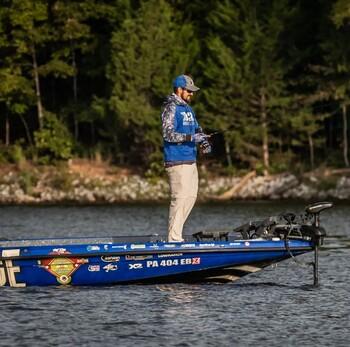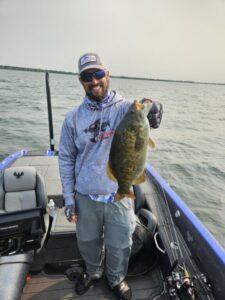Is this FFS sonar debate/trend still going on? Yeah, I figured it was time to finally chime in with my own two cents being on both sides of it.
When I started tournament fishing a little over a decade ago, there was no forward facing sonar. I believe 2D was really it with side imaging and down imaging came shortly afterwards. I came into the sport at a time of serious transition.
Being around it for some time now, I’d categorize a few general types of fisherman (obviously some crossover between them):
- Those who focus on fishing deep (er) and largely rely on their electronics.
- Those that always want to beat the bank.
- Those that prefer fishing specific spots (i.e. the same places – history)
-Note: a lot of fisheries dictate this. Some seem to be more old timey spot lakes where you have to know specific spots to win or be consistent.
- Angler’s who adjust to whichever style or patterns that suit the particular situation. Pattern fishermen would be a loose way to lump this group together.
My first experience with FFS (forward facing sonar) was when the Garmin Livescope first came out. Like many new technologies and products, there is a bit of skepticism that comes with the territory. Some end up being gimmicks or full of bugs and issues during the introduction phase. Others prove to be very useful tools, often as the fishing world goes, kept secret for as long as possible if it is indeed valuable.
In 2018, I got my first ‘Scope’ unit. I believe it was the earliest transducer Garmin made. Like any new thing, I dug into it and tried to learn as much as I could in order to maximize it’s usefulness. It was cool. It was my first time being able to see fish moving around in ‘real time’. Granted, compared to what I now use with Lowrance Active Target it would be like comparing playing Atari to XBox 360. Now, that’s not a knock on Garmin, they were the first, and truly created this boom of FFS and now debate. Even now, Garmin is a great option. I’ve used two different Garmin transducers over the years and have used Active Target now for a couple years. They both have great qualities, pros and cons, but I’ve personally liked Active Target for a few small details. That’s not inherently important to this, but I feel it necessary to explain, I’m not knocking Garmin (they are really good) or any of them. They all have differences and preference seems to be a large part of why one likes one or the other.
When I stepped up to the Garmin transducer right before the current Livescope+ in 2020, I was really impressed with the advances in this technology. The first one helped me incrementally. It was often difficult to separate the fish from the bottom on your screen unless they were moving. Now, with this revamped version, they really didn’t have many places to hide. I liked it a lot, but I found myself still wanting to fish for them. Sometimes that helped me, sometimes it hurt me. I had a strong 16th place finish at the Elite on St. Clair using it part of the time, but day two and three, fishing for them is how I kept improving my weights to climb to where I did. At Santee I made the top 10 that season, largely fishing a flooded cypress forest. Many competitor’s, I later found out, were using Livescope around the trees to throw at fish. Total honesty, I never did. I focused on picking out subtleties in the massive forest to target where I thought bigger fish would set up. The following season at Lake Champlain I used it very sparingly to get a 6th place finish at the Elite. I largely caught my weight shallow with largemouth on cover, sometimes visible, sometimes not. I did weigh one smallmouth day one out deep and one smallmouth day three that I scoped and threw to.
Now, at Erie, and a number of smallmouth fisheries, it opened up a new world. Fish that were suspended and often almost impossible to catch now became targetable. I’ve seen my Active Target excel at spotted bass fisheries as well. I had a really fun event at Lake Hartwell last year, catching fish from 20-50′ in the Bassmaster Open. Still, a few of my bigger bites came on a Carolina rig dragging it on the bottom.
Being able to see fish react in real time is incredible. You can learn so much about the behavior of a bass or even to tell if it is in fact a bass. When I put the Lowrance Active Target on, the first chance I got to see the detailed shape of a big Florida strain largemouth bass at Lake Toho in Florida. I worked my jerkbait above them and watched how they reacted to every twitch and what subtle movements would make the fish uninterested and then finally commit to eating the bait. We’ve never had this capacity to have this responsiveness with electronics in fishing history.
Now, from this, you would probably think, maybe Destin is a “Livescoper”? I think the answer would surprise you. I feel like FFS is an extremely useful tool. It has allowed the learning curve between young anglers and experienced ones to be drastically lessened. It has given us the ability to catch fish that never were targetable. It’s allowed us to be so efficient without casts that it can often be more advantageous not even casting until you see a fish.
On the flip side, it has ruffled some feathers for the following reasons:
- It has allowed younger, less experienced anglers a path to expedite the path to success in bass fishing (generally a feeling from older, more experienced anglers).
- It has made it more difficult to catch fish in fisheries that get a lot of fishing pressure. I have seen this first hand. Just because you can see them, doesn’t mean you can catch them. This honestly first happened with 2D in some places where people traditionally dropped on fish in the same areas, over and over and over. Fish aren’t smart, no matter what we may think some days. They do know how to survive. If they constantly get caught in the same places, they will be harder to trick. It’s not an opinion, it’s a fact proven on fisheries around the country.
- It’s made the sport unattainable for “the working man”. Now, there is some truth to this as I know how our current inflation has made our dollar fall much shorter than it used to. Adding another expensive transducer and often an extra graph to run it can be costly. However, the more I see FFS on kayaks, smaller jon boats and the like, I don’t know how much concrete truth there is to this. It’s a tool. If you need a chainsaw to cut down a tree efficiently, you need a chainsaw to cut down that tree. That may mean saving up a while, or selling a different graph that isn’t as important, but it’s attainable for many in this sport.
- It’s boring to watch on TV. I get this one a bit. It’s not always the most exciting, but I think this is more a product of coverage and not FFS in general. In the Classic this year, they did a great job of showing ‘real time’ shots of Gussy’s (Jeff Gustafson) graph. It was what he was seeing, watching how fish were reacting to hit bait. It was very cool. Most recently, they covered it at the NPFL on Lake Eufaula, Oklahoma. I think to adapt to this way of fishing on TV, there needs to be more showing of what the guys are seeing when they are seeing it. Now, a lot of guys might not like this. The thoughts may be, I don’t want people to see my color pallets, my settings, etc. However, for the sport, I think if this is going to stick around, which almost assuredly, it will, the coverage has to adapt to make it more entertaining and relatable to the end viewer. Sponsors are the lifeblood of this industry and I can almost guarantee you, FFS isn’t going anywhere. Sponsors make a lot of money from these transducers and graphs. Watching how they work in a tournament and seeing how big of fish you are able to target so effectively, why wouldn’t you want to buy it.
I would not consider myself a “Livescoper”. I use it when I feel it is the best tool for the job, but oftentimes, I find myself still fishing shallow or using other tools like 2D and side imaging quite frequently. Has that hurt me the past couple years? Yeah, it very well may have at times. I know I left some events thinking, why didn’t I commit to FFS. Has it helped me? Yes. In my opinion, it’s not going anywhere, so we can choose to complain about it, not adjust, or we can accept it as another tool to add to the tool box and learn how to use it to the highest capacity. At the end of the day, the goal is to have fun. This is achieved by catching as many and as big of fish each trip as we can possibly achieve. I’ll leave it at this, does FFS help achieve this goal?




